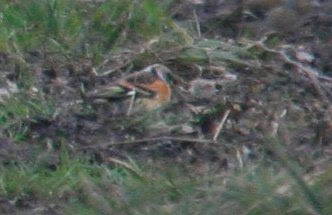My trip to work takes me past a variety of habitats, and there’s often some birds of interest.

First it’s a walk from central Sawbridgeworth to the station, typically leaving the house at 7:15 am to catch the 7:33. As the picture shows, Sawbridgeworth is an old town so there are large gardens with large trees in them. Consequently at the moment there are lots of typical garden birds around. On Wednesday there were 4
Greenfinches, 4
Chaffinches, 2
Goldfinches, a
Mistle Thrush, 7
Dunnocks, 8
Blackbirds, 4
Starlings, 3
Blue Tits, a
Robin, a
House Sparrow, and
Woodpigeons in good numbers. This week a
Great-Spotted Woodpecker has been calling loudly, and on one day there was a flock of
Long-tailed Tits.

Then its across the “river” Stort. Recently there’s been
Mute Swan, and Mallards, or Moorhens are generally about. Today a couple of
Canada Geese flew over.
The station is in the flood plain, and as the photo below shows there are reeds and boggy scrub around. Further up the line is Sawbridgeworth Marsh reserve, Thorley Wash, and then Rushy Meads reserve
At the moment a
Reed Bunting is in residence just opposite the down platform. Last week a few
Fieldfares flew over, Bullfinches are regular as are Wrens, Cormorants go over high on an almost daily basis, occasionally Water Rail call, and in summer there are often most of the commoner warblers singing, Common Terns drifting along the river, and on a couple of occasions Hobby was seen. In autumn, depending on time, small flocks of Woodpigeons migrate south at some height over the station

The train journey into Liverpool Street takes about 40 minutes, and goes past SLRS (1
Lapwing today), past the back of Beckingham Palace, past the Roman Temple site in Harlow, and then along the path of the Stort and Lee into past the Warwick Reservoirs and Walthamstow Marsh. Its all good habitat as
this blog demonstrates. In practise its not possible to see much from the train.

Then it’s a quarter of an hour walk down London Wall, past the Barbican, some preserved remains of bombed out churches from the Blitz and a peek down into the site of the original Roman wall, keeping just north of the Guildhall,then past St Paul's Cathedral and into the office.
Apart from
Feral Pigeons there are generally very few birds – the odd Magpie, Dunnock, and House Sparrow, but recently I’ve heard Robin and Song thrush singing,
Herring Gulls yelping, and the occasional Cormorant flies over.
The reverse trip tends to take place in the gloom at the moment, so the view is more like the one shown below, and there’s generally nothing to add to the list.













 Then it’s a quarter of an hour walk down London Wall, past the Barbican, some preserved remains of bombed out churches from the Blitz and a peek down into the site of the original Roman wall, keeping just north of the Guildhall,then past St Paul's Cathedral and into the office.
Then it’s a quarter of an hour walk down London Wall, past the Barbican, some preserved remains of bombed out churches from the Blitz and a peek down into the site of the original Roman wall, keeping just north of the Guildhall,then past St Paul's Cathedral and into the office.
